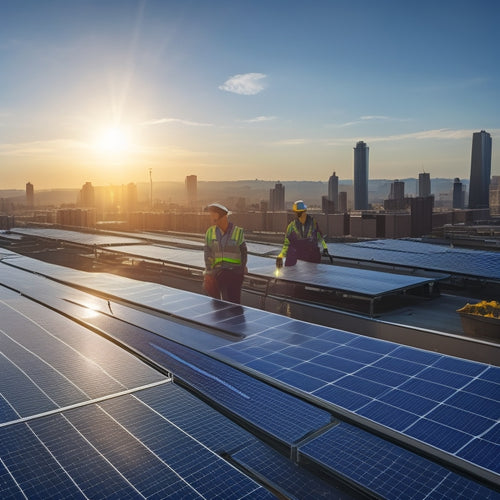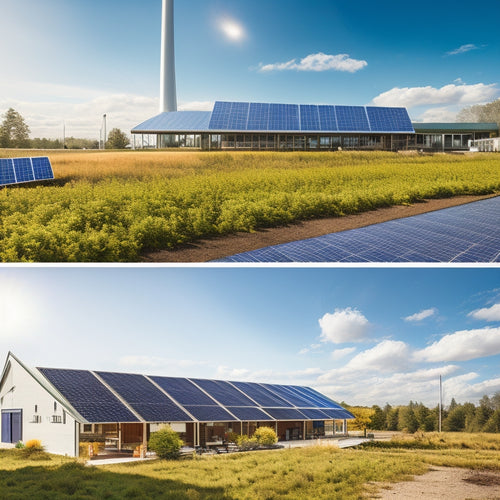Integrating Eco-Friendly Practices in Home Appliance Use
Share
You can substantially reduce your environmental footprint and lower your energy bills by integrating eco-friendly practices into your daily home appliance use. Start by optimizing appliance energy efficiency by replacing energy-intensive appliances with energy-efficient alternatives and conducting an energy audit to identify areas of energy waste. Implement eco-friendly laundry and cleaning practices, such as using detergent alternatives and reusable cloths. You can also adopt smart refrigeration and storage habits, like optimizing fridge temperature and using reusable containers. Explore these practices further to discover more ways to minimize your environmental impact.
Key Takeaways
• Replace energy-intensive appliances with energy-efficient alternatives to minimize energy consumption and reduce environmental impact.
• Conduct an energy audit to identify areas of energy waste and optimize appliance usage for maximum energy savings.
• Implement smart home technologies, such as smart plugs and energy monitoring systems, to track and manage appliance energy usage in real-time.
• Optimize appliance settings, such as refrigerator temperature, to reduce energy consumption and minimize environmental footprint.
• Adopt eco-friendly laundry and cleaning practices, such as using eco-friendly detergents and natural remedies, to reduce environmental impact.
Optimizing Appliance Energy Efficiency
To maximize energy savings, start by identifying the most energy-intensive appliances in your home, such as refrigerators, air conditioners, and water heaters, and replacing them with energy-efficient alternatives. This is a vital step in optimizing appliance energy efficiency.
Conducting an energy audit can help you pinpoint areas of energy waste and identify opportunities for improvement. You can perform a DIY energy audit or hire a professional to conduct a thorough assessment.
Power monitoring is another essential step in optimizing energy efficiency. By monitoring your energy usage, you can identify patterns and trends that can help you make informed decisions about your energy consumption.
You can use smart plugs or whole-home energy monitoring systems to track your energy usage in real-time. This data can help you identify which appliances are the most energy-intensive and make adjustments accordingly.
Eco-Friendly Laundry and Cleaning
As you continue to optimize your home's energy efficiency, you'll want to turn your attention to another substantial contributor to your environmental footprint: your laundry and cleaning habits.
Your laundry room is a great place to start making eco-friendly changes. Begin by switching to detergent alternatives like soap nuts or eco-friendly detergent pods.
These alternatives are gentler on the environment and still provide effective cleaning power. When it comes to stain removal, try using natural remedies like baking soda, white vinegar, or lemon juice to lift tough stains.
These methods aren't only eco-friendly but also cost-effective. Additionally, consider upgrading to energy-efficient washing machines and dryers, which use markedly less energy and water than traditional models.
Smart Refrigeration and Storage
Your refrigerator is likely one of the most energy-hungry appliances in your home, making it a prime target for eco-friendly upgrades. By adopting smart refrigeration and storage practices, you can significantly reduce your energy consumption and minimize food waste.
Optimize your fridge temperature: Keep your fridge between 37°F and 40°F to reduce energy consumption.
Label and date leftovers: Clearly label leftovers with the date they were cooked or stored to ensure you consume them before they expire.
Store food wisely: Organize your fridge to ensure that frequently consumed items are easily accessible, reducing the need to open the door excessively.
Sustainable Air Quality Management
By maintaining a well-ventilated home, you can prevent the buildup of pollutants and allergens, ensuring a healthier indoor environment. A well-designed ventilation system is essential in removing stale air and introducing fresh air from outside. This can be achieved through natural ventilation methods, such as opening windows, or mechanical ventilation systems, like whole-house fans.
| Air Purification Method | Effectiveness | Cost |
|---|---|---|
| HEPA Filters | High | Moderate |
| Activated Carbon Filters | Medium | Low |
| UV Light Purifiers | Low | High |
In addition to ventilation, air purification systems can further improve indoor air quality. These systems utilize various technologies, such as HEPA filters, activated carbon filters, and UV light purifiers, to remove pollutants and allergens from the air. By combining ventilation systems with air purification methods, you can create a healthy and sustainable indoor environment. By taking these steps, you'll not only improve your indoor air quality but also contribute to a healthier and more eco-friendly home.
Energy-Saving Kitchen Essentials
Optimizing your kitchen's energy efficiency starts with selecting appliances that minimize power consumption without sacrificing performance. When it comes to energy-saving kitchen essentials, every detail matters. From lighting to countertops, each element plays a vital role in reducing your carbon footprint.
These key considerations can help:
Energy-efficient lighting: Replace traditional incandescent bulbs with LED or CFL alternatives, which consume less energy and last longer. Consider installing motion sensors or timers to optimize kitchen lighting usage.
Countertop design: Choose countertops made from sustainable materials, such as recycled glass or eco-friendly composites, which reduce waste and minimize environmental impact.
Appliance selection: Look for appliances with the ENERGY STAR label, which indicates they meet energy efficiency standards set by the U.S. Environmental Protection Agency.
Frequently Asked Questions
Can I Use Eco-Friendly Cleaning Products in My Dishwasher?
You can use eco-friendly cleaning products in your dishwasher if they're specifically designed for dishwasher use and have a green certification, ensuring dishwasher compatibility and a reduced environmental impact.
How Do I Properly Recycle Old or Broken Appliances?
You'll guarantee responsible recycling by properly disposing of old or broken appliances through designated facilities or manufacturer take-back programs, allowing for environmentally friendly appliance disposal and minimizing electronic waste.
Are Energy-Efficient Appliances Worth the Higher Upfront Cost?
You'll find energy-efficient appliances worth the higher upfront cost, as they offer lifecycle savings through reduced energy consumption and may even come with hidden incentives, such as rebates or tax credits, that offset the initial investment.
Can I Use a Power Strip to Control Multiple Appliances at Once?
You can use a power strip to control multiple appliances at once, but consider upgrading to smart plugs with energy monitoring capabilities to optimize your energy usage and track consumption in real-time.
Do Energy-Efficient Appliances Require Special Maintenance?
You'll be relieved to know that energy-efficient appliances don't require special maintenance, but following recommended maintenance schedules can boost appliance longevity, ensuring they continue to perform efficiently and effectively.
Related Posts
-

Solar Installation Guide for Commercial Properties
Implementing solar energy solutions in your commercial property can lead to significant long-term savings and sustain...
-

Sustainable Home Design for Reduced Carbon Footprint
Sustainable home design is your pathway to a smaller carbon footprint and a healthier living space. By incorporating ...
-

Off-Grid Solar Solutions for Eco-Conscious Businesses
Off-grid solar solutions offer you a path to both sustainability and substantial cost savings. By adopting these syst...


